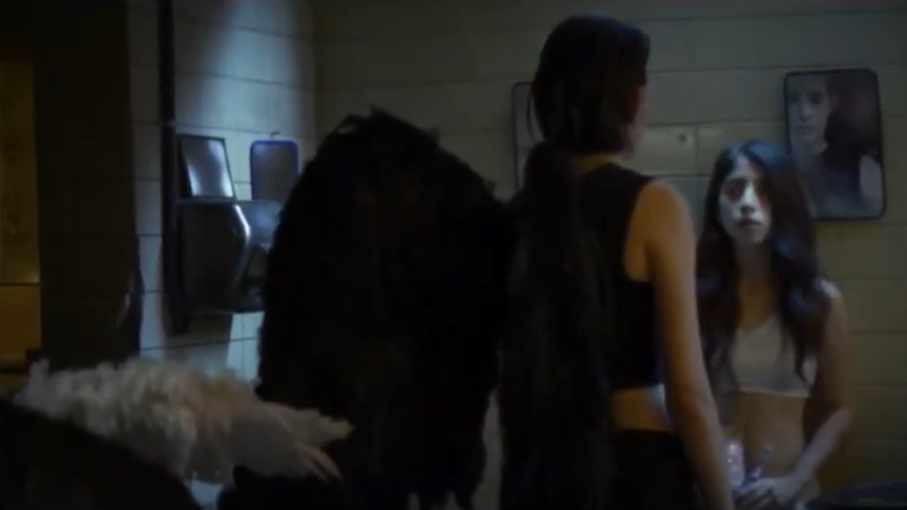Rita
2024

Rated: R
Genre: Dark Fantasy, Drama
Country: Guatemala
Run-Time: 1h 47min
Director: Jayro Bustamante
Cast
Giuliana Santa Cruz…………………….Rita
Alejandra Vásquez Carrillo……….Bebé
Glendy Asturias Rucal………………..Gladys
Ángela Joana Quevedo……………..Sulmi
Spanish-speaking directors seem to have the edge on mixing horror elements with a mature, fairytale-style setting to deliver profound social and political commentary. It’s an approach that seems like a natural progression from the literary contributions of Gabriel García Márquez and his skillful knack at combining his dark, satirical wit with magical realism. And though Márquez’s stories could often get morbid, nobody ever considers him a horror writer. Yet anyone who has read the short story “A Very Old Man with Enormous Wings” knows there is something about the tale that still gets under the skin despite its dry humorous tone- and that’s because what the story suggests about the selfish cruelity human nature. This is not simply “A Tale for Children”.
It’s not hard to speculate about how the dark socio-political critiques and fantasy elements of authors like Gabriel García Márquez acted as an influence on director Guillermo del Toro, whose 2006 Pan’s Labyrinth still holds up as the shining example of a dark fantasy film with mature social commentary. At times, the goals and genre characteristics of magical realism and dark fantasy can seem so aligned it becomes difficult in a genre conversation to distingiush the two- especially when the dark fantasy grounds itself in the real world.
Since Pan’s Labyrinth, films people label as “adult fairy tales” have been growing in prominence- with many telling nightmarish coming-of-age tales that overlap real-world strife with fantasy worlds that are only accessible to the story’s children. A recent example of this is 2017 film Tigers Are Not Afraid by Mexican director Issa López- which tells the story of a girl orphaned by the drug cartels that is granted three wishes to help her survive.
Of course, this type of dark fairy tale is not being exclusively used by Spanish-speakers either. Kenneth Dagaton 2023 film In My Mother’s Skin mixes Filipino folklore in with the real-world threat of Japanese occupation during the end of World War II. In this movie, the young protagonist turns to a fairy in the forest to help her ailing mother while her father is off pleading for rebel assistance.
Which brings me to Jayro Bustamante’s 2024 film Rita, his follow-up to 2019’s La Llorona. For those who do not know, Jayro Bustamante is a director from Guatemala who is quickly becoming one of the most significant figures currently using film as a form of activism and awareness against the past injustices.
Bustamante is becoming increasingly known for making films that use magical realism in a way that makes impossibly bleak material more digestible. In his 2019 film La Llorona, Bustamante ambitiously tackles the genocide of Guatemala’s indigenous population in the 1970s and 80s by telling the story of an aged dictator haunted by a vengeful spirit. In his follow-up film Rita, he uses fantasy elements to depict the events surrounding the 2017 tragedy at the Guatemalan Virgen de la Asunción Safe House which resulted in the death of forty-one girls.
Give Bustamante credit. The man will not shy away from any topic he sets his sights on, no matter how difficult or horrible.
Rita starts with the title character’s arrival at the safe house. As Rita (Guiliana Santa Cruz) is getting processed, it becomes immediately clear that the hallways of the safe house appear like a prison for teenage girls. And it does not take long for Rita, herself only thirteen, to observe otherworldly sights in the safe house, as veiled girls in black that are trailed by unnatural glowing gold orbs reveal themselves to her. (Later, we will learn that this group of girls are called the “Stars”.)
Fortunately, a voice over by Rita before she enters the safe house helps give us a bit of context for the fantasy elements to come. The fantasy elements are part of Rita’s coping mechanism to deal with the horrors within the safe house and help her to tell the story. But interesting, it is also implied throughout the film that the fantasy is also collectively shared by all the girls as a kind of a group hallucination in order to make their own sense of their limited nightmarish world.
What kind of nightmares? Well, the male guards are mostly pedophiles that what their way with them. Some of the girls are trafficked to clients for sex. The girls are often tricked into taking sexually explicit photos of themselves by a woman who claims she grew up in the safe house and was once like them. Oh…and the food sucks.
And don’t expect help to come from the social worker. I hear she’s a real witch. (Actually, in the parallel fantasy reality, she actually gets depicted as a witch.)
The girls are treated like criminals, but when we learn of Rita’s own harrowing story it’s pretty obvious a lot are just runaways who fled abuses at home only to be collected by the State and put in another abusive situation under the guise of “for their protection”.
The girls end up being divided into groups and Rita ends up being placed with the angels- which are girls who wear costumed wings on their back. Other groups include the bunnies, princesses, fairies and stars. All of the groupings have both a fantasy element and a sinister sexually exploitative element to them. It’s pretty awful.
The girls who habitate the safe house are an interesting paradoxical mix. They are victims, but Bustamante doesn’t depict them as weak. Over time, they have developed strategies to rebel against their captures and are starting to see themselves as revolutionaries. They even have a plan to escape their captors, but it only works if Rita agrees to play a pivital part.
As a director, Bustamante is becoming known for being able to get powerful dramatic performances out of first-time actors. As the story’s lead, actress Guiliana Santa Cruz is excellent, but I found myself equally entertained by the character of Bebé (Alejandra Vásquez), a girl who is always in the know but seems easy to underestimate. In her own way, she is surprisingly strong.
But, as we approach the film’s tragic conclusion and that ill-fated decision that leads towards inevitable demise of so many, we are reminded that these characters are, in fact, just girls- not seasoned revolutionists. They misjudge the cruelity, and perhaps deperation, of their captors and that makes their horrible end all the more terrible.
I find it fascinating that Shudder has become the platform that showcases Bustamante’s work in North America. Like La Llorna, Rita is not horror in a traditional sense, so some of the people who put this on will naturally be upset. I admit, I write that sentence a lot, but this time I’d like to add that horror fans looking for more traditional movie frights might still like this one anyways. A good movie is a good movie and in many comments I notice that Bustamante’s work often gets a pass despite their lack of scares and gore because of the respect people end up having for the power and importance of his social commentary. And I imagine Shudder likes being a home for Bustamante’s work because his movies help to add a little international prestige to the platform. It’s a bit of a win-win.
With Rita, Bustamante has made a dark fantasy with powerful real-world social implications- especially to those who live in Guatemala or fight for women’s rights around the world. He exposes the dangers some girls are forced to endure when a country fails to commit to their safety or provide them simple human rights. Or worse- when a country seems to actively put them in institutions that intentionally exploit them.
In the ever growing canon of coming-of-age dark fantasy films, Rita stands out as being one of the best.
